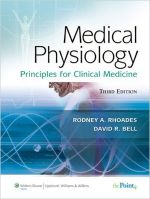Now in its Third Edition, this text clearly and concisely presents the physiological principles that are essential to
clinical medicine. Outstanding pedagogical features include Active Learning Objectives that emphasize problem-solving
applications of basic principles; conceptual diagrams that help students visualize complex processes; case studies,
Clinical Focus boxes, and From Bench to Bedside boxes; a comprehensive glossary; and online USMLE-style questions with
answers and explanations. This edition features a new Immunology and Organ Function chapter and a completely rewritten
and reorganized cardiovascular section.
A companion Website will include the fully searchable text, an interactive question bank, case studies with practice
questions, animations of complex processes, an image bank, and links for further
Part I: CELLULAR PHYSIOLOGY
Ch. 1: Homeostasis and Cellular Signaling
Patricia J. Gallagher, PhD
Ch. 2: The Plasma Membrane, Transport and Resting Membrane Potential
Stephen A. Kempson, PhD
Ch. 3: Action Potential, Synaptic Transmission, and Maintenance of Nerve Function
Cynthia J. Forehand, PhD
Part II: NEUROMUSCULAR PHYSIOLOGY
Ch. 4: Sensory Physiology
Richard A. Meiss, PhD
Ch. 5: The Motor System
John C. Kincaid, MD
Ch. 6: The Autonomic Nervous System
John C. Kincaid, MD
Ch. 7: Integrative Function of the Nervous System
Cynthia J. Forehand, PhD
Ch. 8: Skeletal and Smooth Muscle
Richard A. Meiss, PhD
Part III: BLOOD AND IMMUNOLOGY
Ch. 9: Blood Components
Gabi Nindl Waite, PhD
Ch. 10: Immunology, Organ Interaction and Homeostasis
Gabi Nindl Waite, PhD
Part IV: CARDIOVASCULAR PHYSIOLOGY
Ch. 11: An Overview of the Cardiovascular System and Hemodynamics
David R. Bell, PhD
Ch. 12: The Electrical Activity of the Heart
David R. Bell, PhD
Ch. 13: Cardiac Muscle Mechanics and the Cardiac Pump
David R. Bell, PhD
Ch. 14: The Systemic Circulation
David R. Bell, PhD
Ch. 15: The Microcirculation and Lymphatic System
David R. Bell, PhD
Ch. 16: Special Circulations
David R. Bell, PhD
Ch. 17: Control Mechanisms in Circulatory Function
David R. Bell, PhD
Part V: RESPIRATORY PHYSIOLOGY
Ch. 18: Ventilation and the Mechanics of Breathing
Rodney A. Rhoades, PhD
Ch. 19: Gas Transfer and Transport
Rodney A. Rhoades, PhD
Ch. 20: Pulmonary Circulation and Ventilation-Perfusion
Rodney A. Rhoades, PhD
Ch. 21: The Control of Ventilation
Rodney A. Rhoades, PhD
Part VI: RENAL PHYSIOLOGY AND BODY FLUIDS
Ch. 22: Kidney Function
George A. Tanner, PhD
Ch. 23: The Regulation of Fluid and Electrolyte Balance
George A. Tanner, PhD
Ch. 24: Acid-Base Balance
George A. Tanner, PhD
Part VII: GASTROINTESTINAL PHYSIOLOGY
Ch. 25: Neurogastroenterology and Motility
Jackie D. Wood, PhD
Ch. 26: Gastrointestinal Secretion, Digestion, and Absorption
Patrick Tso, PhD
Ch. 27: The Physiology of the Liver
Patrick Tso, PhD
Part VIII: TEMPERATURE REGULATION AND EXERCISE PHYSIOLOGY
Ch. 28: The Regulation of Body Temperature
Frank A. Witzmann, PhD
Ch. 29: Exercise Physiology
Frank A. Witzman, PhD
Part IX: ENDOCRINE PHYSIOLOGY
Ch. 30: Endocrine Control Mechanisms
Jeffery S. Elmendorf, PhD
Ch. 31: The Hypothalamus and the Pituitary Gland
Robert V. Considine, PhD
Ch. 32: The Thyroid Gland
Robert V. Considine, PhD
Ch. 33: The Adrenal Gland
Robert V. Considine, PhD
Ch. 34: The Endocrine Pancreas
Jeffrey S. Elmendorf, PhD
Ch. 35: Endocrine Regulation of Calcium, Phosphate, and Bone Homeostasis
Jeffery S. Elmendorf, PhD
Part X: REPRODUCTIVE PHYSIOLOGY
Ch. 36: The Male Reproductive System
Jeffery S. Elmendorf, PhD
Ch. 37: The Female Reproductive System
Robert V. Considine, PhD
Ch. 38: Fertilization, Pregnancy, and Fetal Development
Robert V. Considine, PhD
Appendix: Common Abbreviations in Physiology
Glossary
Index


